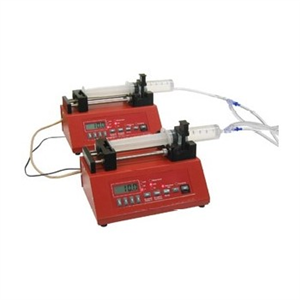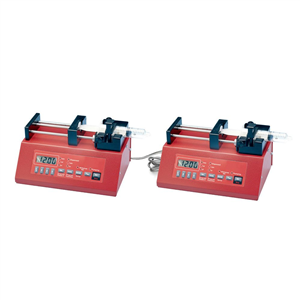

AL-DUAL-AL-1000X
Continuous Aladdin Pump System (Two Aladdin AL-1000X SyringeONE NeXtGen Syringe Pumps with sync cable for continuous flow)
- Overview
- Specifications
- Accessories
- Citations
- Related Products
Overview


There are 2 images available to view - click to enlarge and scroll through the product gallery.
AL-DUAL-AL-1000X Instruction Manual
/ Download as PDF
- Includes 2 x AL-1000X pumps and sync cable for reciprocating use
- Eliminates flow rate pauses and drop-offs
- Each pump accepts syringe sizes: 1-60mL, or 0.5-5 uL
- Programmable, economical, verstaile
- Network, control, and monitor up to 100 pumps with one computer
The Dual-X System allows the two pumps to communicate with each other through a synchronization cable. The system is flexible and can the pumps casn be configured to operate in:
- Continuous flow (push/pull configuration requires p-dkit optional check valve set)
- Emulsification
- Independently
Eliminates Flow Rate Pauses & Drop-Offs
The AL-DUAL-AL-1000X Continuous Pump System eliminates the problem of flow rate drop-offs and pauses found in Push-Pull syringe pump systems. With Push-Pull systems, one syringe infuses, while the other refills, then they switch directions. This switch of directions causes a delay in flow while the syringes are primed.
The AL-DUAL-AL1000X Continuous Pump System solves the inconsistent flow rate problems of push-pull pumps.
How it works:
The refilling syringe pump fills the syringe at a faster rate than the infusing syringe pump infuses, giving it time to prime the syringe after the syringe is filled, or even overlap the infusion to create a seamless transition between syringes.
The smoothness of the transition between syringes can be fine tuned by adjusting the infusion rate, refill rate, priming rate, prime volume and overlap volume parameters.
Each AL-1000X pump offers
- Applications range from simple infusions to complex pumping programs
- Gradient ramping of flow rates
- Automatic dispensing of small volumes
- Very precise, reproducible flow rate control
- Displays total volume dispensed in mL or µL units
- Selectable infusion/withdrawal rate units (mL/hr, µL/hr, mL/min, µL/min)
- Infusion rate can be changed while pumping
- Program pump via keypad or from a computer
- Highly controllable – program sequences without a computer (holds up to 41 programming phases)
- Motor stall detection
To meet the demands of a busy lab Aladdin Pumps offer exceptional value providing versatility and reliability for accurately dispensing media down into the nanoliter range.
The Aladdin AL-1000X is a programmable single channel infusion / withdrawal syringe pump. It has a metal casing to provide stability, ensuring less vibration is transferred to the syringes. Setup is easy using the pumps keypad or via a computer with optional PC to pump cable (GN-PC7 or GN-PC25).
The Aladdin AL-1000X can run complex programs with up to 41 pumping phases can be set to change pumping rates; set dispensing volumes; insert pauses; control and respond to external signals; sound the buzzer.
| Channels Per Pump | 1 |
| Type | Infusion / Withdrawal |
| Flow Range | 0.001 µL/hr (0.5 mL syringe) to 3470 mL/hr (140 mL syringe) |
| Dispensing Accuracy | ±1% |
| Syringe Sizes Accepted | 0.5 µL to 60 mL or 140 mL partially filled |
| Linear Force | 35 lb at low speed; 18 lb at maximum speed |
Example Flow Rates
| Syringe Size | Maximum Rate | Minimum Rate |
| 0.5 µL | 25.49 µL/hr | 0.001 µL/hr |
| 1 mL | 52.86 mL/hr | 0.727 µL/hr |
| 3 mL | 223.8 mL/hr | 3.076 µL/hr |
| 5 mL | 372.5 mL/hr | 5.119 µL/hr |
| 10 mL | 607.6 mL/hr | 8.349 µL/hr |
| 20 mL | 966.2 mL/hr | 13.28 µL/hr |
| 30 mL | 1260 mL/hr | 17.32 µL/hr |
| 60 mL | 2120 mL/hr | 29.1 µL/hr |
| 140 mL | 3470 mL/hr | 47.7 µL/hr |
Specifications
AL-1000X Aladdin Syringe Pump
| SYRINGE SIZES | 1-60 mL, or 0.5-5µL micro syringes |
| NUMBER OF SYRINGES | 1 |
| MOTOR TYPE | Step Motor, 1/8 to 1/2 step modes |
| STEPS PER REVOLUTIONS | 400 |
| STEPPING (max. min.) | 0.21µm to 0.850µm |
| MOTOR TO DRIVE SCREW RATIO | 15/28 |
| SPEED (max./min.) | 5.1 cm/min / 0.0042 cm/hr |
| PUMPING RATES | 1699 mL/hr with 60 mL syringe, to 0.73µL/hr with 1 mL syringe |
| MAXIMUM FORCE | 35 lb at min. speed, 18 lb at max. speed |
| NUMBER OF PROGRAM PHASES | 41 |
| RS-232 PUMP NETWORK | 100 pumps maximum |
| POWER supply | Wall adapter 12V DC @ 850 mA |
| DIMENSIONS | 22.9 x 14.6 x 11.4 cm (8.75 x 5.75 x 4.5 in.) |
| WEIGHT | 3.2 kg |
Accessories
P-DKIT
Dual Pump Plumbing Kit for use with continuous/dual infusion Aladdin Pump setups.
Citations
Birngruber, T., & Ghosh, A. (2013). Cerebral open flow microperfusion: A new in vivo technique for continuous measurement of substance transport across the intact blood–brain barrier. Clinical and …. Retrieved from https://onlinelibrary.wiley.com/doi/10.1111/1440-1681.12174/full
Ferreira, D., Reis, R., & Azevedo, H. (2013). Peptide-based microcapsules obtained by self-assembly and microfluidics as controlled environments for cell culture. Soft Matter. Retrieved from https://pubs.rsc.org/EN/content/articlehtml/2013/sm/c3sm51189h
Herricks, T., Avril, M., Janes, J., Smith, J., & Rathod, P. (2013). Clonal Variants of Plasmodium falciparum Exhibit a Narrow Range of Rolling Velocities to Host Receptor CD36 under Dynamic Flow Conditions. Eukaryotic cell. Retrieved from https://ec.asm.org/content/12/11/1490.short
Maya, H., Vincent, M., & Nötzli, S. (2013). Increased porosity of electrospun hybrid scaffolds improved bladder tissue regeneration. … Research Part A. Retrieved from https://onlinelibrary.wiley.com/doi/10.1002/jbm.a.34889/full
Tõnurist, K., Thomberg, T., & Jänes, A. (2013). Polymorphic Behavior and Morphology of Electrospun Poly (Vinylidene Fluoride) Separator Materials for Non-Aqueous Electrolyte Based Electric Double Layer. ECS …. Retrieved from https://ecst.ecsdl.org/content/50/45/49.short
Tõnurist, K., Thomberg, T., Jänes, A., & Lust, E. (2013). Specific Performance of Electrical Double–Layer Capacitors Based on Different Separator Materials and Non–Aqueous Electrolytes. ECS Transactions. Retrieved from https://ecst.ecsdl.org/content/50/43/181.short
Zander, N., & Orlicki, J. (2013). Electrospun polycaprolactone scaffolds with tailored porosity using two approaches for enhanced cellular infiltration. Journal of Materials …. Retrieved from https://link.springer.com/article/10.1007/s10856-012-4771-7
Zhang, J., Jiang, D., & Peng, H. (2014). A pressurized filtration technique for fabricating carbon nanotube buckypaper: Structure, mechanical and conductive properties. Microporous and Mesoporous Materials. Retrieved from https://www.sciencedirect.com/science/article/pii/S1387181113005192
Zhang, J., Jiang, D., Peng, H., & Qin, F. (2013). Enhanced mechanical and electrical properties of carbon nanotube buckypaper by in situ cross-linking. Carbon. Retrieved from https://www.sciencedirect.com/science/article/pii/S000862231300568X












Request
Catalogue
Chat
Print